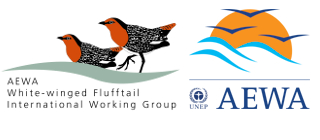Current Size: 76%
Range States
White-winged Flufftails are known to regularly occur within 2 countries in the AEWA area: South Africa and Ethiopia. These "Principle Range States" are listed in the AEWA Single Species Action Plan for the White-winged Flufftail and have the major responsibility for the implementation of the Action Plan. Subsequently, these range states are all members of the AEWA White-winged Flufftail International Working Group, charged with coordinating the international implementation of White-winged Flufftail conservation measures.
Countries are seen as belonging to the Principle Range States if they host one or more Important Bird Areas (IBAs) for the Whte-winged Flufftail.
Short descriptions of the occurence of White-winged Flufftail in each range state are provided below.
COUNTRY PROFILES
South Africa
South Africa currently hosts the only known regular wintering site for the White-winged Flufftail. These birds are usually found in the high altitude wetlands of the Eastern Escarpment between November and March. In January 2018 the first breeding record of White-winged Flufftail was recorded at Middelpunt Wetland, Mpumalanga fundamentaly altering what we knew about this elusive species. In South Africa, the wetlands used by these flufftails are permanently or semi-permanently wet, and they are typically sponges located near the headwaters of rivers in the eastern Highveld, which are wet underfoot, and dominated by the sedge Carex acutiformis, a broad-leafed plant that forms a closed canopy about 1-15 cm high above the ground layer of damp ground or shallow water.
Ethiopia
Until January 2018, Berga wetland was thought to be the only breeding site for this elusive species. A breeding record has now been recorded in the neighbouring wetland adjacent to Berga. Birds are usually observed in the Berga wetland between June and August. In Ethiopia they favour seasonal flooded wetlands, stretches of grass and sedge standing about knee-height in ankle-deep water in summer.







